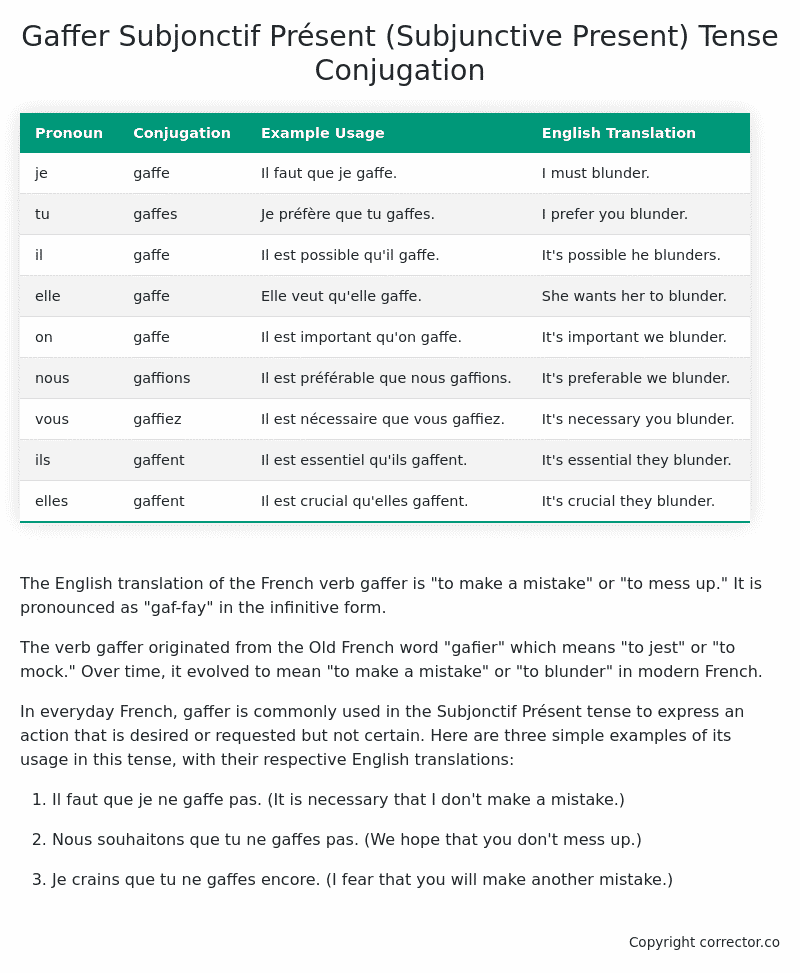Subjonctif Présent (Subjunctive Present) Tense Conjugation of the French Verb gaffer
Introduction to the verb gaffer
The English translation of the French verb gaffer is “to make a mistake” or “to mess up.” It is pronounced as “gaf-fay” in the infinitive form.
The verb gaffer originated from the Old French word “gafier” which means “to jest” or “to mock.” Over time, it evolved to mean “to make a mistake” or “to blunder” in modern French.
In everyday French, gaffer is commonly used in the Subjonctif Présent tense to express an action that is desired or requested but not certain. Here are three simple examples of its usage in this tense, with their respective English translations:
-
Il faut que je ne gaffe pas. (It is necessary that I don’t make a mistake.)
-
Nous souhaitons que tu ne gaffes pas. (We hope that you don’t mess up.)
-
Je crains que tu ne gaffes encore. (I fear that you will make another mistake.)
Table of the Subjonctif Présent (Subjunctive Present) Tense Conjugation of gaffer
| Pronoun | Conjugation | Example Usage | English Translation |
|---|---|---|---|
| je | gaffe | Il faut que je gaffe. | I must blunder. |
| tu | gaffes | Je préfère que tu gaffes. | I prefer you blunder. |
| il | gaffe | Il est possible qu’il gaffe. | It’s possible he blunders. |
| elle | gaffe | Elle veut qu’elle gaffe. | She wants her to blunder. |
| on | gaffe | Il est important qu’on gaffe. | It’s important we blunder. |
| nous | gaffions | Il est préférable que nous gaffions. | It’s preferable we blunder. |
| vous | gaffiez | Il est nécessaire que vous gaffiez. | It’s necessary you blunder. |
| ils | gaffent | Il est essentiel qu’ils gaffent. | It’s essential they blunder. |
| elles | gaffent | Il est crucial qu’elles gaffent. | It’s crucial they blunder. |
Other Conjugations for Gaffer.
Le Present (Present Tense) Conjugation of the French Verb gaffer
Imparfait (Imperfect) Tense Conjugation of the French Verb gaffer
Passé Simple (Simple Past) Tense Conjugation of the French Verb gaffer
Passé Composé (Present Perfect) Tense Conjugation of the French Verb gaffer
Futur Simple (Simple Future) Tense Conjugation of the French Verb gaffer
Futur Proche (Near Future) Tense Conjugation of the French Verb gaffer
Plus-que-parfait (Pluperfect) Tense Conjugation of the French Verb gaffer
Passé Antérieur (Past Anterior) Tense Conjugation of the French Verb gaffer
Futur Antérieur (Future Anterior) Tense Conjugation of the French Verb gaffer
Subjonctif Présent (Subjunctive Present) Tense Conjugation of the French Verb gaffer (this article)
Subjonctif Passé (Subjunctive Past) Tense Conjugation of the French Verb gaffer
Subjonctif Imparfait (Subjunctive Imperfect) Tense Conjugation of the French Verb gaffer
Subjonctif Plus-que-parfait (Subjunctive Pluperfect) Tense Conjugation of the French Verb gaffer
Conditionnel Présent (Conditional Present) Tense Conjugation of the French Verb gaffer
Conditionnel Passé (Conditional Past) Tense Conjugation of the French Verb gaffer
L’impératif Présent (Imperative Present) Tense Conjugation of the French Verb gaffer
L’infinitif Présent (Infinitive Present) Tense Conjugation of the French Verb gaffer
Struggling with French verbs or the language in general? Why not use our free French Grammar Checker – no registration required!
Get a FREE Download Study Sheet of this Conjugation 🔥
Simply right click the image below, click “save image” and get your free reference for the gaffer Subjonctif Présent tense conjugation!

Gaffer – About the French Subjonctif Présent (Subjunctive Present) Tense
Formation of the Subjonctif Présent
Common Everyday Usage Patterns
Interactions with Other Tenses
Summary
I hope you enjoyed this article on the verb gaffer. Still in a learning mood? Check out another TOTALLY random French verb conjugation!


